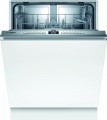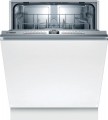Number of place settings
The maximum number of dish sets that can be loaded into the dishwasher at one time. A set is considered a set of dishes for one person: four plates (for the first course, for the second course, salad, bread), a plate for dessert, a cup, a spoon and a fork.
The large capacity allows you to wash numerous dishes in the device at one time without starting the washing programme again. At the same time, excess capacity is just as undesirable as insufficient. Firstly,
a capacious operating chamber affects the dimensions of the entire device. Secondly, such units consume more water. Thirdly, if there is not much dirty dishes, you either have to wait until it accumulates, or start an underloaded device, wasting water and detergents. Therefore, when choosing according to this indicator, real needs must be taken into account and not chase after the maximum capacity.
Noise level
The approximate noise level produced by the dishwasher during operation. In modern models, this parameter can range from 37 – 39 dB (muffled human voice) to 59 – 60 dB (loud conversation); more detailed decoding of what sound corresponds to a particular number of decibels can be found in special tables. Anyway, the
low noise level contributes to the comfortable use of the device. It is especially important if the dishwasher is to be used at night (for example, if there are reduced electricity rates at night).
Noise class
Allows people to decode the values of the noise level in decibels. It is marked in Latin letters like other classes, where A is the quietest class of dishwashers.
Washing modes
—
Own programme. Possibility to create and save a custom programme by setting the parameters to your liking. This function is convenient because instead of setting the washing settings manually each time, it is enough to save them once in the device’s memory and then simply select a user programme from the list.
—
Half load. A special programme for cases when the dishwasher is loaded with only half of its regular capacity. Running a full-fledged wash in such cases would be too wasteful; so in the half load mode, the dishwasher reduces the consumption of water, detergents and electricity, focus on a reduced amount of dishes. Such a programme is relevant mainly for roomy models (from 8 sets).
—
Pre-rinsing. The "soaking" mode is a program that rinses dishes with cold water and keeps them from drying for a long time, preventing food residues from sticking to the plates. It's useful for storing unwashed dishes for a long time, and for washing heavily soiled dishes without using intensive washing programs.
—
Quick wash. A quick wash programme that saves time. Designed mainly for lightly soiled dishes that do not require particularly intensive exposure; for cope with serious pollution is not suitable.
—
Automatic. This program allows the dishwasher to monitor the washing proc
...ess using sensors that evaluate the water composition during rinsing. The washing process ends when the water is free of impurities, ensuring optimal resource consumption. The washing mode varies by model, with some offering only standard automatic programs and others allowing users to choose the water temperature.
— Economical. A programme that reduces the consumption of water, detergents and electricity compared to a normal washing cycle. Usually, it is intended for dishes without heavy soiling and dried food residues, although individual models may have their own features of the economy mode.
— Delicate (for glass). Special programme for washing delicate dishes, especially that are made of thin glass (goblets, wine glasses, etc.). Washing is carried out at low temperatures (to avoid drops) and with minimal mechanical actions, which allows you to keep delicate dishes intact.
— Hygienic. This program is designed to destroy pathogenic bacteria and viruses effectively. It uses elevated water temperatures (around 68...70°C) that can provide a bactericidal effect without special detergents. This mode is useful for washing children's dishes and can be helpful when someone in the family is sick.
— Intensive. Special programme for washing heavily soiled dishes, such as pans with dried-on food residues. Usually, it provides increased pressure and elevated water temperature.
— Night(quiet). This program is designed for use at night or in situations where excessive noise is undesirable. It reduces the noise produced by the dishwasher by decreasing water temperature, pressure, and using other techniques depending on the model. The necessary washing efficiency is maintained by increasing the operating time, making it suitable for use at night.
— Steam treatment. Hot steam treatment can be used to soften dried food residues and sterilize jars and utensils for home canning. The process consumes a lot of energy.
In addition to the above, other types of programs may be indicated in the specs of dishwashers, in particular:
— Normal. Standard programme for washing lightly soiled dishes with a full load at temperatures around 65 °C. Available in almost all modern dishwashers, but sometimes manufacturers specify its availability separately.
— Plastic utensils. The programme is designed for washing reusable plastic dishes at lower temperatures and intensity than the standard programme to avoid scratches and damage caused by high heat. Not all plastic dishes are compatible with dishwashers, so compatibility should be checked separately. Washing disposable dishes is not recommended.
— Mixed. This category includes all programs that combine several washing modes at once — for example, the normal mode in the compartment for cups and glasses, and the intensive one in the lower part, where you can put a pot or frying pan. Options for such combinations may be different, depending on the model.
— Self-cleaning. Special programme to remove deposits and disinfect the dishwasher. Self-cleaning mode heats water with detergents to remove moderate pollution, and can be run multiple times for tough deposits.Country of origin
The country in which the model is manufactured. Despite the fact that most of the capacities are concentrated in China, European factories (
Germany,
Italy,
Poland,
Turkey) for the production of household appliances have not gone away. And certain models can be produced on them. In general, such a division into a Chinese or European factory should not particularly affect the quality of products, but still the stereotype of a reliable European assembly is present in us. However, it is possible that the model may have a country of manufacture, for example, Poland, and in the store under the same article you will meet China.

